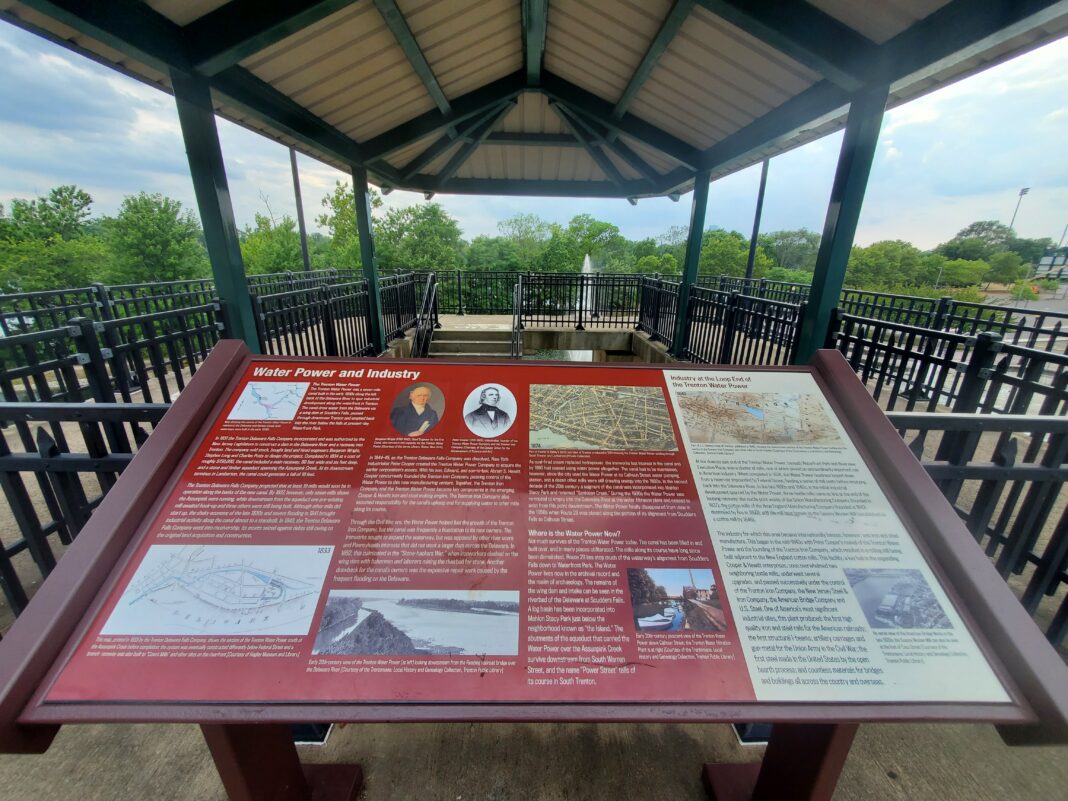For Historic Trenton’s Day in the Life, we’re looking back through newspapers from the beginning and examining everyday problems, solutions, and needs during historic Trenton’s past. Today, we look at the history of the Trenton Water Power, known as Sanhican Creek, initially built by the Trenton Delaware Falls Company.
For several years before 1830, according to the Sunday Times, there had been numerous petitions for creating a canal or a waterway to take water from the Delaware River for furnishing power to manufacturing establishments in Trenton. Then John Green, the innkeeper in Trenton, helped pass an act to incorporate a company to “create water power at the city of Trenton and its vicinity.”
Green and other Trentonians created the Trenton Delaware Falls Company with a subscription to the stock at $60,000, $50 a share, and a group of men set to work in Trenton.
According to the History of Trenton, 1679-1929, water was diverted from the Delaware river by a wing dam about six miles above Trenton and carried by canal down alongside the Delaware River to the Assunpink Creek through Trenton. The water power passed through various ownerships throughout its century of existence, including the firm of Cooper and Hewitt, pioneer iron manufacturers in Trenton. For most of the century, the dominant factory on the Trenton Water Power was the Trenton Iron Company below Federal Street.
“In 1844-45, as the Trenton, Delaware Falls Company was dissolved,” writes HMdb.org, the historical marker database. “New York industrialist Peter Cooper created the Trenton Water Power Company to acquire the earlier corporation’s assets. With his son, Edward, and son-in-law, Abram S. Hewitt, Cooper concurrently founded the Trenton Iron Company, passing control of the Water Power to this new manufacturing venture.”
Then in 1853, the Trenton Iron Company bought up all the stocks in the Trenton Water Power Company to better secure the rolling mill’s power supply and rent out the used mills. Numerous mills operated on the banks of the canal, according to records, a half dozen more, producing products such as flour, iron, bricks, cotton, wool, lumber, and paper.
According to a booklet by the New Jersey Department of Transportation and Federal Highway Administration called Power to The City, the Trenton Water Power, an official report of 1885, inventoried 15 mills along the channel’s route. “The mills can obtain full capacity. However, during several months, the power sank as low as one-half at times, so many of the mills have steam in reserve.” By the 1890s, only 12 mills were using the canal as power.
The company stocks were considered worthless by the decade’s end. This was because companies on the canal used coal-fired steam power and had little use of the canal’s hydropower. Hardships would ensue as increasing repairs caused by ware and tare and a flood that crippled the channel for years. Abram Hewitt, the owner of Trenton Water Power Company, was willing to sell to anyone for pennies on the dollar.
Throughout the decade and the early years of the next century, Abram Hewitt would try in vain to sell the rights to the canal. Finally, in 1910, the Cooper and Hewitt families gave the rights to the American Bridge company. There it stayed until the 1920s.
According to the Times of Trenton, in 1928 a preliminary action was taken during special meeting with the Board of City Commissioners to purchase the channel. By a three to two vote in favor of an ordinance sanctioning the condemnation, The City of Trenton purchased the Trenton Water Power company to power city plants.
Then in what is believed to be the Trenton State Gazette, in November of 1929, Trenton formally acquired the property of the Trenton Water Power Company. The sale of the stream and land on each bank was purchased for $200,000, and an additional $15,000 for Harvey Island.
Most of the Trenton Water Power was filled in the 1920s. The rest of the canal became known as Mahlon Stacy Park and continued to supply the city’s water-pumping station and filtration plant. It was used as a swimming hole by residents, and boaters would frequently use it as a way to relax, though that changed in the 1950s. Construction of route 29 along the rest of the canal led to it being covered up almost completely.





